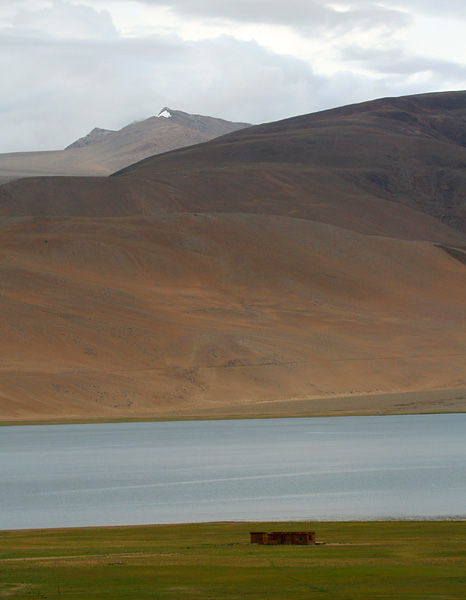
Tso Moriri Lake
Tso Moriri gave me a feeling of being in an enormously beautiful, secret location. Enormously beautiful doesn’t need much explanation. If you have seen pictures of the bright blue lake held captive by mountains around it, challenging the sky in a who-is-more-blue contest, you already know what I am talking about. The sky was hardly blue while I was there, but it did not matter. And it feels secretive, not because no one knows about it, but at any given point of time there are so few people in your vicinity and the place is so far away from anywhere else, it almost gives a feeling of being in your own private heaven specifically built to please you. It is an almost flawless place. The surrounding mountains have just a little bit of snow lurking on their peak, adding a nice bright contrast to blue and brown landscape. On the bank of the lake is a wide stretch of lush green grass like you would see nowhere else in the desiccated Ladakh. Horses graze unattended along the greens, creating an impression that a small group of nomadic trotters must have sought a temporary shelter somewhere nearby.
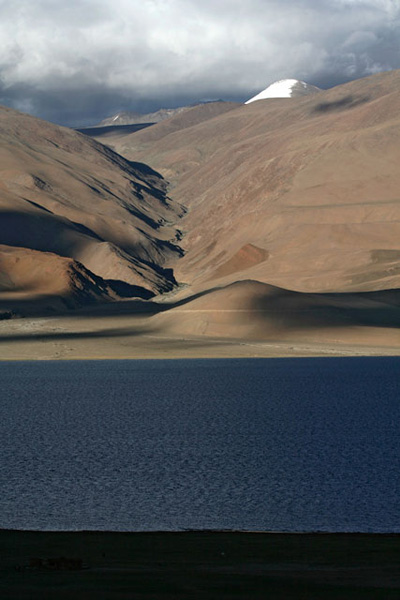
Tso Moriri Lake and the snow capped mountains
Ladakh is a place that has etched many memories in me, but no other place has made a deeper mark than Tso Moriri. The reasons are many. The tiny bits of snow on the peaks had always remained a great attraction for me. It snowed on the peaks on the days I was there, depositing beautiful buttery white powder all along the slopes. The dark gloomy clouds that gathered before the snowfall enriched and darkened the blueness of the lake.
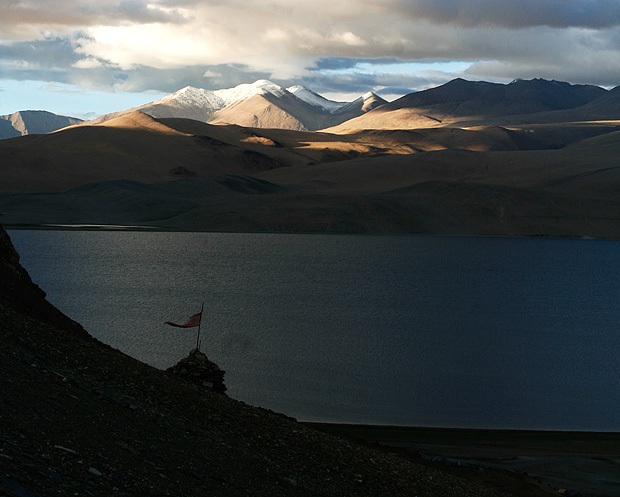
The lake and the mountains beyond at the hour of sunset, with a stupa in the foreground.
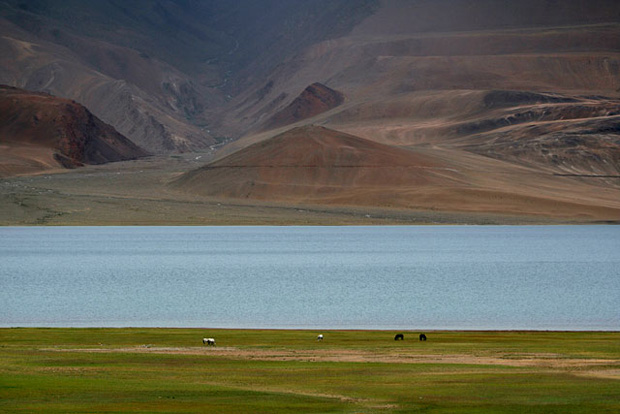
Horses graze on the bank of Tso Moriri
But there was more to Tso Moriri than the lake itself. The ebullient people of Korzok (the village on the bank of Tso Moriri) added to the charm. There was an inexpressible grace in everything they did, be it milking the goats, working in the fields or herding the sheep back into the village in the evenings. The monastic festival at Korzok Gompa added to the chirpy atmosphere. If I had an option of staying forever in Tso Moriri, I think I would have taken it.
+ Buy prints of these and other images of India Travel Blog
“Where is the bathroom?” I asked the girl who showed me a room in her guesthouse. She had a beautiful room with lot of space and a thick bed with colourful sheets on it. The insides were sparsely furnished, but whatever existed was tastefully decorated with a dash of traditional Ladakhi paintings. I loved the place and would have been happy to stay there for the next five days of my stay at Korzok Village. But her face fell the moment when I asked her about bathroom. “No bathroom,” she said and led me down the stairs. Pointing to a steel basin and a vessel full of water on the ground, she helpfully indicated that we can wash our hands and face there, but there aren’t any bathrooms.
I wasn’t exactly ready to stay in a room with no bathing facilities, but had anticipated for guesthouses to not have bathrooms. At Pangong Lake only a few days ago, a home-stay owner had shrugged when we asked for a bathroom and pointed in the direction of the lake. We were finally lucky to find a place with a bath at Pangong. But here in Korzok Village deeper inside Changthang Plateau, where our options of accommodation were a choice of expensive luxury tents and basic guesthouses, I wasn’t sure if there was something of a compromise between the two that offered a place to wash ourselves.
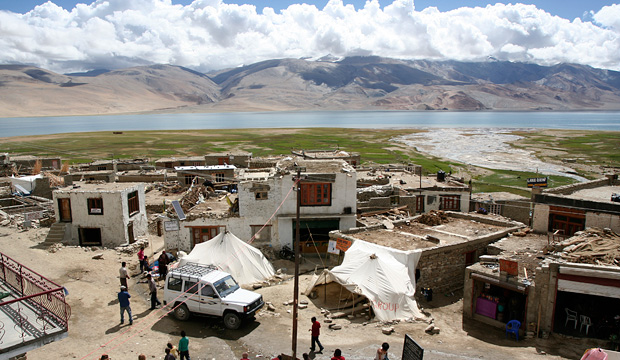
Korzok Village
Changspa (chanspa, chang pa), the people of Changthang, do not exactly think freshening up everyday is one of their priorities. The winter here is so harsh that temperatures dip below -30C, while summer is a terribly busy season when they spend every second of waking time busy working. In a place where there is no plumbing, no running water and no electricity, a bath is a great effort and doesn’t figure high in the list of things to do. And when you have a 12,000 hectare deep blue lake only a stone’s throw away from where you live, you don’t really need a bathroom for that once-in-a-while bathing ceremony.
But spending four days without bath was not exactly something I fancied. Every other house in Korzok has a ‘home-stay’ sign hanging in front of it, but not too many of them came with bathrooms. We must have spent a good thirty minutes before finding one that fit the bill – a simple room with a washroom.
Earlier in the day, we had started from Leh early in the morning, making the long and monotonous journey upstream Indus to Tso Moriri. Passing through now-familiar road that took us till Upshi, where a road deviated towards Manali, we drove further upstream where the river becomes narrow and swift, while the mountain slopes became steeper. Good roads allowed us to cover the distance quickly as we passed through barren landscapes and occasional villages with a dash of greenery around them. Stopping at Chumathang briefly for a cup of tea we did not want to drink next to a hot-spring that we did not want to see, we continued towards Mahe Bridge, where the road cuts across Indus and enters the Changthang Plateau.
Passing through Tso Kiagar, a small lake that we see an hour before, we arrived at Tso Moriri at 2pm to see a large expanse of superb blue colours of the lake, its other end far enough to be not visible. Our road skirted the lake shore, where a bar headed geese drifted gently in the waters, tailed by its five inquisitive chicks. Korzok Village was visible a few kilometers away, located on a slope just above the lake.
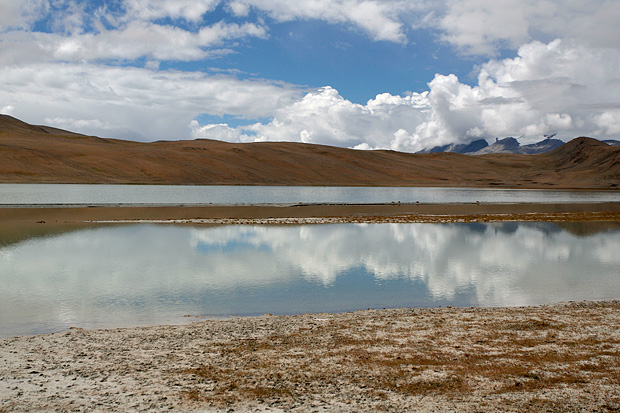
Tso Kiagar Lake
Korzok is a small village with perhaps fifty families living on the bank of Tso Moriri. As in every Ldakhi Village, a monastery and a bunch of haphazard chortens higher up the slopes dominated the village. The place looked like work-in-progress, akin to our larger cities, with lot of construction in progress either to modernize their dwellings or to build more accommodation for tourists. At 225km from Leh, Korzok is far from any large town and is yet to see modern facilities like electricity and regular public transport. The approach to the village is getting better by the years and a tarmac road now ends just half an hour before the village. It would be a matter of few years before the village gets to inhale the first smell of tarmac.
I spent the first day at Korzok lazing in the room and staring at the lake from my window for a few hours and then sauntering in the village in the evening hours. The next few days were to be spent exploring the village, watching a monastic festival and visiting the nomad herders of changthang plateau.
+ Also see: Drive from Leh to Tso Moriri and conversations with driver Rigchen
+ Map of Korzok Village and places on the way from Leh to Tso Moriri.
View Leh to Tso Moriri in a larger map





